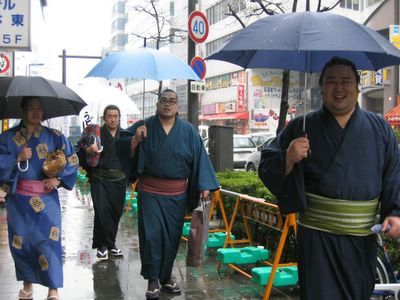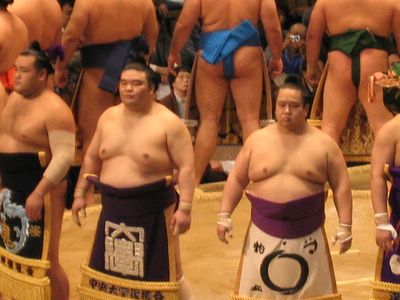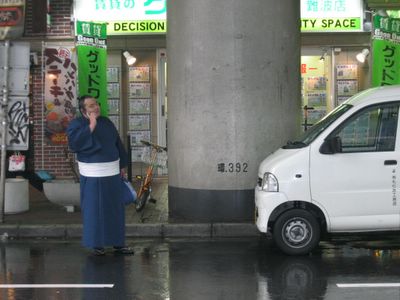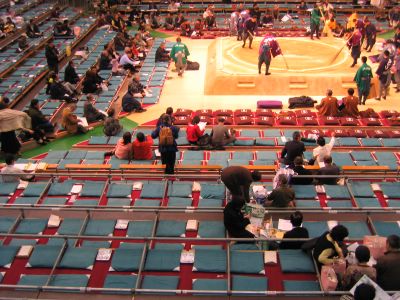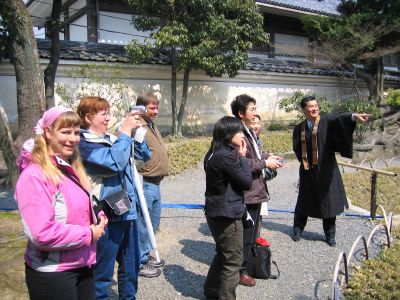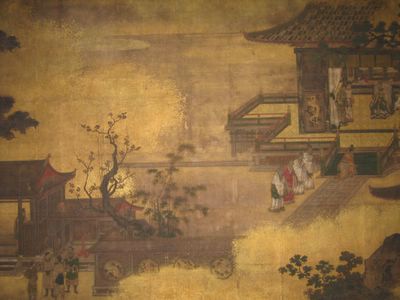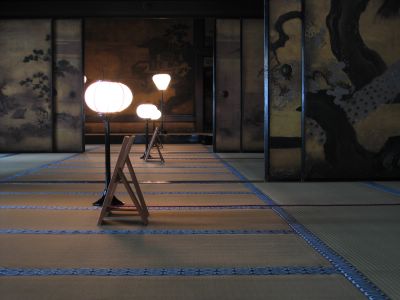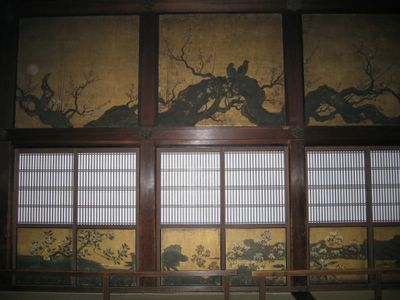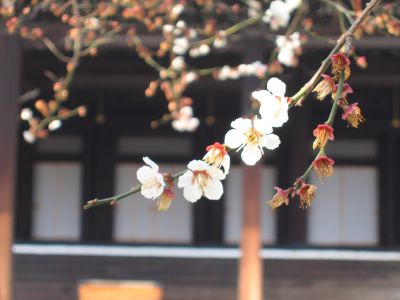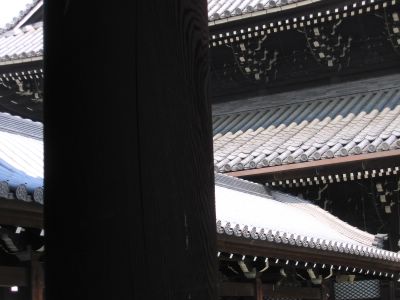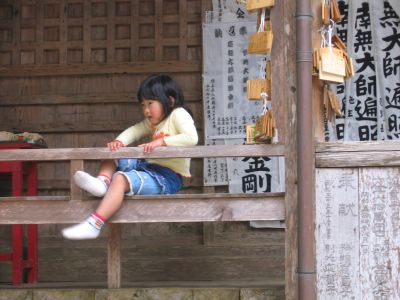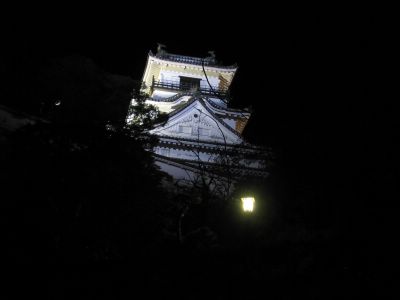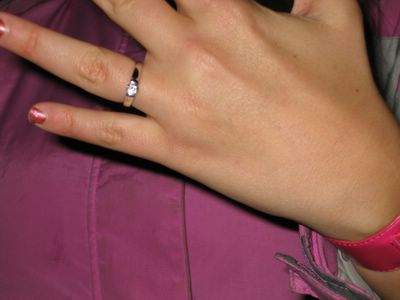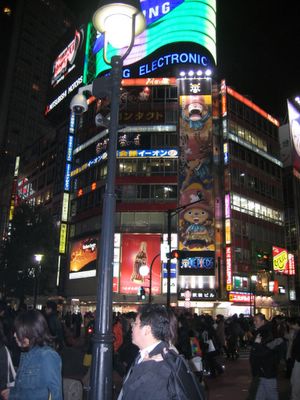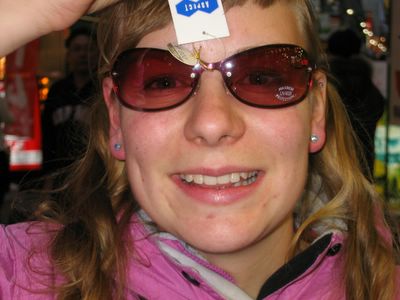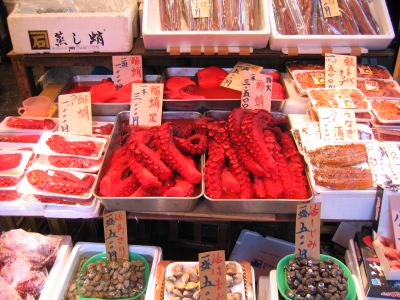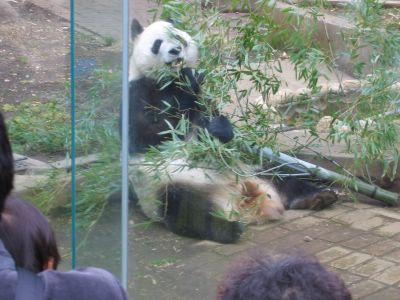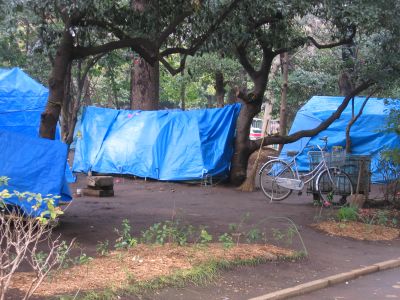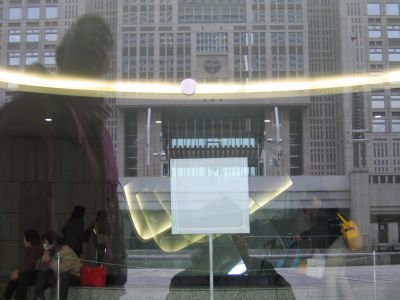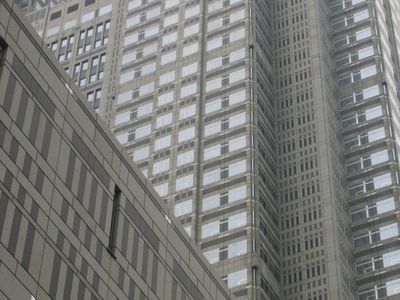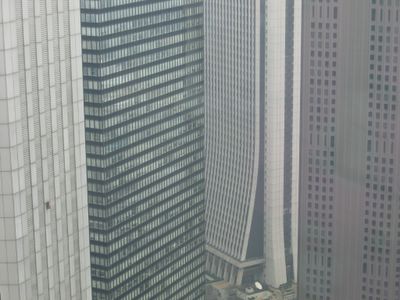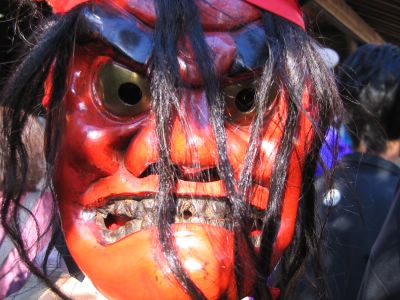Onegaishimasu
The Amazing Adventures of Jon and Nancy
Thursday, March 31, 2005
Wednesday, March 30, 2005
As with most jobs, JET has busy time and down time. Right now is down time, which I've been passing like an old pro: blogging, googling, drinking too much coffee and staring intently at the filing cabinets. I'm excited for busy time.
One good thing about down time, though, is that I'm pretty much free to come and go as I please. I've taken advantage of the opportunity by knocking off early every day to play go with Shimasaki-san. It's a difficult game, but Shimasaki-san is a good teacher.
Basically, go is a battle for space. I suppose the idea is similar to chess, but not really. For one thing, there aren't any characters as in chess. The game starts by placing pieces onto the board, not moving them around: once a piece is played, it can't be moved. Also, each piece needs at least one breathing space to live, a breathing space being one of the four lines extending directly from that piece. The more pieces connected in a line, the more breathing spaces and, hopefully, the more territory. I think that about sums it up.
There is a lot of strategy, which I don't understand whatsoever. I've started to notice a few patterns, though. For example, its a good idea to join pieces together, otherwise Shimasaki-san puts a piece in the middle, cutting one piece off from the rest, thus gaining more territory. Its also a good idea to not retaliate or enter battle right away; better to claim territory, then enter into battle. There's more, too, but I haven't really figured it out yet.
Shimasaki-san has been playing go for 25 years. He considers himself 3-dan, which basically translates into totally-kick-ass. He jokes that I'm still a baby, which I am. But he says we can practice three or four times a week until I get better. Soon, I'll be busy though, and I don't know how much I can practice. I'll be wishing for the down times then.
Tuesday, March 29, 2005
We were told we would be able to see the sweat fly. Turned out our seats weren't that close. Luckily, sumo wrestlers are so big you can see them from a mile away.
We saw our first one on the train into Osaka. Coming out of the train station, we came across a whole group out for a stroll. They smiled when they noticed our camera and even posed for a group shot.
We got to the stadium early. The place was nearly empty as the no-name, not-fat wrestlers did their thing. As the day wore on, the stadium filled to capacity.
Each time a new group of wrestlers entered the ring, they did a little ceremony. And before each fight, there was even more ceremony. In fact, you could hardly see the wrestling for all the ceremony.
When a fight finally looked like it might break out, people would holler out the name of their favourite wrestler. The favourite didn't always win, though. Usually, the guy with the least amount of visible injuries won. Or the guy with the best balance. Surprisingly, the biggest guys didn't necessarily win.
The reigning yokozuna, a 24-year-old Mongolian named Asashoryu, demolished his competitor to move to 23 straight victories. His was the last match of the day, and both wrestlers ended up in the front seats. I saw the sweat fly on that one.
After the tournament there was a bow dance, which is supposed to be important and interesting. It wasn't, really, but the sumo sure was. I hope to go again some day.
Saturday, March 26, 2005
In Kyoto, Higashi-hongan-ji was undergoing renovation. Undaunted, we headed down the street to Nishi-hongan-ji, which was also under wraps for restoration work. Down but not out, we decided to poke around anyway, to see what we could see.
It didn't take long to come across a tourist information booth handing out pamphlets and such. Three Japanese people were chatting there with a Buddhist priest. I thought it was a little strange that they all had English pamphlets and said as much, which got a conversation started. We were all surprised to find that the priest was also from Kochi Prefecture, down Muroto way. And that one of the girls in the group would soon be leaving for Canada to study English. What a coincidence! It was enough for an invitation to a private tour of the temple, a UNESCO world heritage site and head temple of the True Pure Land sect of Buddhism, with 12 million followers worldwide.
We were led into an unassuming office. From there we walked through a plywood corridor and finally into the temple corridors. The first room we entered featured ink-paintings of bamboo and tigers. Well faded from 400 years of exposure to the elements, our guide-priest thought nothing of letting us touch the paintings to get a better feel for the craftsmanship. From there we came across one of the first noh stages constructed in Japan, a building with near magical accoustics. I could almost imagine the shogun clapping in approval.
Inside the temple, we passed through room after room of 400 year old ink paintings done on gold foil. I recognized most of them from school textbooks. Our guide-priest pulled back tourist barriers and let and us wander freely throught the rooms, even allowed flash photography. Just as we were getting overloaded from golden shadow, we were led into a corridor where our guide pulled back a sliding screen door to reveal the most beautiful garden.
Outside, the carp pool had been drained for cleaning. Our guide pointed out a boat laying in the muck, said it was used by the priests to get from one building to the next. He then led us into yet another building, this one featuring the shogun's tearoom, the ceiling and doorway set lower than usual to prevent any swordfights from breaking out. The kicker was when we were told we were the first Canadians to ever be inside that room and that not even if the Prime Minister himself could book a visit.
After, we posed for a group photo and to have a chat. On our way out, we were given tea to sip on. Leaving the temple grounds, none of us could believe what had just happened! I still can't!
Friday, March 25, 2005
After finally telling everyone through telephone calls, email, and the gossip train, I can finally post some big news. If you didn't get my message and this is the first time you have heard anything about it, I apologize!
On February 12th, Jon proposed to me!!! We're engaged! Want to know the details? Read on...
We were celebrating Valentine's Day. It all began with a lie in (which, let me tell you, is a rare thing with our schedules) and a homemade breakfast of waffles with fresh maple syrup and some mixed fruit in unsweetened yogurt. I'm just kidding. I don't remember what we ate. We just ate something for breakfast.
Anyways, at Christmas time we started the 88 temple pilgrimage and decided that today, our Valentine's Day would be the perfect time to visit some more of the temples along the ocean. There is a famous road on Shikoku Island called Yokonami Skyline that runs parallel to the ocean. The scenery is amazing. The temples are only open until 5 p.m. so after our last temple, which we arrived at just in time, it was off to Kochi city for some Valentine's Day shopping and a romantic dinner.
Jon had made reservations at one of our favorite restaurants called Tofu-ya. It is a restaurant that serves tofu in every dish. It is one of the very few restaurants that will adapt to vegetarians. I recommend the tofu steak and the mango tofu smoothie.
I have always wanted to take pictures of Kochi castle at night but it just never worked out. After exchanging our Valentine's Presents, we decided tonight was the perfect night to take pictures of the floodlit castle. We preceded up the stairs, laughing and taking pictures along the way.
At the top of the stone stairs, Jon pulled me over to the side and said, "I have a question for you." I, completely oblivious, replied, "OK. What?" Jon started fishing around in his pocket and I still had no clue. He got down on one knee and at first I though he was kidding. I knew he had been looking at rings when we returned to Canada for summer vacation but he had convinced me that he had not been able to bring it to back to Japan. I thought he was playing a trick and remember thinking, "This is the meanest joke ever. It is not funny at all because we had such a romantic day." I though about hitting him. Luckily for him, he asked his question before I had a chance to follow through.
"Will you marry me?" My heart started fluttering. I realized it wasn't a joke and he really was asking me. He placed the ring on my finger and of course, I said yes.
We haven't decided any details except that the wedding will take place somewhere in Saskatchewan. We will begin the preparations once we return to Canada. The tentative date is set for sometime in July, August, or September of 2006.
Thursday, March 24, 2005
Ueno made for an excellent introduction to both Tokyo and Japan. The first public park in Tokyo, the area is loaded with museums and temples, a zoo and, perhaps most interesting of all, a homeless village.
Feeling overloaded and hungry from our tour through the Tokyo National Museum, we decided to walk toward the amusement area for some lunch. On the way, we came across a large group of men seated in the middle of an open area. Passing by, we realized they were homeless and were in the middle of some sort of village meeting. Not wanting to disturb the proceedings, we continued past the homeless village - dozens of elaborate blue tents set in a large treed area. The colonized area appeared to have all the amenities of normal village life - roadways, garbage collection areas, electricity and cooking areas. For those interested, I found this link about homelessness in Japan.
Next we went to the zoo, where we saw a couple of giant pandas. The first guy was snoozing, which wasn't so exciting, but the second was happily munching on bamboo. I like pandas!
From the zoo, we walked across the street to Ameya Yokocho, a lively shopping district selling everything from fresh octopus to designer bags. They had cheap sunglasses, too, so Nancy bought a pair.
Finally, we went to Shibuya, one of the busier shopping districts in Tokyo. As expected, it was crazy-packed with people, neon and noise.
Wednesday, March 23, 2005
Having slept as contortionists in a three-sizes-too-small clear plastic box, Nancy and I stepped dazed and confused from our night bus into the rush hour hum of Shinjuku Station. Quickly, for a sizable pile of vomit rested in the far corner and a man conducting a perm stood next to me, I washed and brushed in a subway bathroom. After Nancy had had her turn, we headed underground for a taste of rush hour, the madness of the JR men stuffing an estimated two million daily commuters into train cars coming one-two-three always ever after. For thirty minutes we watched streams of people navigate rivers of diesel and steel and afterward decided we were happy it wasn't us jammed that way by the JR men.
From Shinjuku it was but a short travel by moving walkway to the relative calm of Nishi-Shinjuku's skyscraper district, where we elevated to the 45th floor of Kenzo Tange's Tokyo Metropolitan Government Building. Although the view from 248 meters was impressive, I much preferred that of Metropolitan Square, styled, it would seem, on the Roman Coliseum. With office workers rushing to and fro, we took a moment to wander the sculptured esplanade and admire the concrete and aluminium mega-structure that disappeared at the cloud line.
Our mini-tour finished, we left for the airport where we greeted Nancy's parents. They were happy to arrive, if not tired from nearly 24 hours in transport. We checked into our hotel and walked to a nearby izakaya for some grub: sushi, udon, yakitori, yakimeishi and others. Chopsticks in hand, each dish was greeted with a quizzical, "What's this?" almost always followed by, "Mmm, its pretty good." After dinner was bed, a solid nights sleep and dreams of Ueno.
Tuesday, March 22, 2005
We're back from our tour of Japan. On March 10, we took the night bus to Tokyo where we met Nancy's parents at the airport. From there, we visited a good chunk of Japan: Shinjuku at rush hour, the Tokyo Metropolitan Government building, the Tokyo National Museum, Ueno Zoo, Shibuya, Roppongi, Tokyo Disneyland, Tsukiji and the Imperial Palace; Kyoto Station, Yasaka, Nishi-honganji, Ginkakuji, Kinkakuji and Gion; the spring basho in Osaka; Himeji; Hiroshima; and Miyajima. I'll write more later.
Thursday, March 10, 2005
Last Sunday we went to Yamada Taiko, the best known taiko group in Kochi. A friend of ours with the unfortunate nickname of Ika-chan a.k.a. Mister Squid is a member and played everything with reckless abandon, especially the odaiko a.k.a. the big the fat drum. But he’s a skinny runt of a man compared to the group leader whose name I do not know. A squat, barrel-chested, pony-tailed dude of about 50, group leader has arms like tree trunks and man oh man did he bang a drum. He banged fast, he banged slow and to top it all off he blew a mean shakuhachi a.k.a. bamboo flute. But the show was more than just men in fundoshi a.k.a sumo diapers pelting drums. One of the women performers had obviously risen to the rank of right hand and banged with the speed and fury of Baraka gone rabid on vitamin R a.k.a eating the shit out of Zangrief’s forehead. There were the children, too, all done up in psychedelic yukata a.k.a. florescent pink and blue bathrobes. They came on stage to the enjoying of the this is traditional Japanese game a.k.a paper balloons and marbles and cup and ball. And all the while the group leader wailing on the shakuhachi and Mister Squid whomping the odaiko with a baseball bat and right hand woman tokatoka-ing a million miles an hour and nobody ever missing a beat not even for a second. Needless to say, we bought the CD.
Tuesday, March 08, 2005
More pictures from the Naked Man festival, courtesy of Andrew in Kochi.
Thursday, March 03, 2005
Wednesday, March 02, 2005
After a long break, I’ve started studying Japanese again. Lately, I’ve been studying Japanese onomatopoeia, which is used all the time in Japanese. When coffee drips into a pot, that’s potapota; when a heavy object rolls it goes gorogoro; to separate once and for all is to go kippari; when someone dies suddenly they go pokkuri; to answer with great ease makes a surasura sort of noise; and when someone goes senile they go yobuyobu. It’s great, because there are even rules as which sounds represent which type of emotion or action. For example, the short “u” represents aspect of human psychology while the soft “sh” represents a quiet or emotive state. So now I can invent my own words. Now, I go uguugu in the night and shurushuuru in the morning. Well, back to the books.
